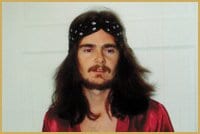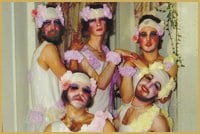
Dennis Robbins, 1972 Credit: Photo courtesy of Dennis Robbins
I arrived in Vancouver from Ontario in 1968 at the age of 21.
I headed for the beach almost immediately.
On my way there, I crossed a construction site at the foot of the Burrard St Bridge and got stopped by the police.
“What are you up to?” they asked.
I told them I was heading to the beach to see the Pacific Ocean.
“Don’t you know that homosexuals walk up and down there all night long?” they asked.
“No, I didn’t know that,” I replied, and promptly hurried down.
That night my new social life began, and in two months I was living in a West End penthouse and going to smart parties. In another year I would be managing Faces, the most popular gay club in town.
That first year, my roommate Gerry Cole and I did the clubs, going to the 795 Club to dance, the August Club to catch the first drag show and Champagne Charlie’s to see the fabulous Dee Dee Ambrose perform.
The B&B (its official name was the Betwixt and Between) was great for cruising and would become the Playpen South. The August Club would become the Shaggy Horse. All the clubs had jukeboxes and we heard the same songs over and over.
Back then, life was fun and exciting for a young gay man just coming out. Of course, being gay was still illegal, so it wasn’t always easy. The clubs didn’t have signs out front like they do today. You just had to know where to find them.
But they were great–like being part of a secret underground society. In some ways, being gay back then was more fun than it is today. We could really be who we were in those spaces. There was a real sense of freedom.
Gerry got a job working for Vincent Burt and Gary Husband, who had a couple of struggling wig shops called Gone With The Wig and the Wigwam, on Dunsmuir. In October 1969, they purchased the 795 Club, renovated it and opened Faces. It would soon become one of the most popular gay clubs in town.
It was colour coordinated in black and red, with Art Nouveau-style faces painted in Day-Glo on two walls and Vasarely Op-Art wallpaper on another. A mirror ball, strobe lights and a colour organ made for a great light show. And its state of the art sound system, dual turntables and a reel-to-reel tape recorder were the first in Vancouver.
But despite its obvious potential, Faces was not an immediate success and after two months it still didn’t have a clientele. Part of the problem may have been that its manager came to work in a suit and you couldn’t dance to the music.
Things changed a week before the New Year 1970 when I agreed to manage Faces and took charge of the music.
I bought all the latest albums and 45s. I would head down to Seattle and sometimes San Francisco to purchase the Black American music that wasn’t available here. I put Gerry on music and asked him to play Motown and Rhythm & Blues. He soon became a favourite DJ and had numerous fans.
That New Year’s Eve we had 150 people. After that, the club started to catch on in the emerging gay community. We soon had up to 300 people a night on weekends. Faces became famous.
The club’s reputation even extended down the coast to California, where it was sometimes called the Stud North after the Stud, a popular gay bar in San Francisco.
Back then, Vancouver had really strict, almost prohibitionist liquor laws, and Faces was by no means exempt.
Like many other clubs, it was licensed as a private bottle club and everyone had to buy a membership and sign the membership book. (But unlike in the straight clubs, many of our patrons were afraid to use their own names, which is probably how Marlene Dietrich, Joan Crawford and Mae West became Faces members.)
Having purchased your membership for $1 and signed in, you could then bring your own booze, check it at the bar and get it served back to you.
Admission on the weekend was $1 before 11 pm and $2 after. We often had a rush right before 11 pm, then most people would go back to the Castle and the Ambassador to finish their beer. Afterwards, they would return to Faces and dance to our great music until 4 am.
I often played music at peak times to get the guys aroused on the dance floor. “Gimme Shelter” by The Rolling Stones, or “Rock Steady” by Aretha Franklin would usually do it. “The Ghetto” by Donny Hathaway became our theme song.
After a year, we decided to admit women. It was the time of gay liberation and some of the guys wanted to bring their female friends. So we started by opening the club to women on one night, then every Monday night, then on Fridays, and soon women could come in every single night of the week. There was some resistance in the beginning, but not too much. It just seemed like the thing to do.
By the time it reached its first birthday, Faces needed a facelift.
It would be the new ’70s look: brick and boards, with a raised dance floor that doubled as a stage. We all took our turns performing on that stage.
On one trip to San Francisco, I met two members of The Cockettes, Hibiscus and Sylvester. The Cockettes were a theatrical troupe of hippy drag queens with beards, dresses and glitter. Sylvester would cut an album and have huge disco hits like “You Make Me Feel Mighty Real.”
Here in Vancouver we launched our own troupe in 1972 called The Facettes, made up of Faces staff and club members.
The Facettes were Ruby Tuesday, Chenie Ripple, Peach de Vogue, Mabel, David Divine and Gerry Cole. Other members joined in at times. Ivan Sayers provided some of the costumes, and for the 1973 Valentine’s Day show their dresses were made from sheer curtains.
One night we hosted a Lou Reed concert and four of The Facettes dressed up as cheerleaders and performed before the show. The audience loved them! Lou Reed himself called them “sick little girls.” We all took it as a huge compliment. I still have the pictures.
In the three years I managed Faces, I only had to call the police twice since we had few fights. The first time, two thugs unsuccessfully tried to break down the heavy doors with crowbars, but took off when they heard the sirens.
The second time, four tough hustlers broke in the back exit. The leader grabbed me, threw me to the floor and held a knife to my throat. Luckily, I knew him as a member and was able to talk him into leaving.
Twenty minutes later the police came, and in the course of talking about the incident they mentioned that they generally left us alone. Did that mean we shouldn’t have called them?
Relations between the gay community and the police were strained in those days. We didn’t trust the police. In the 1960s, they regularly raided our bars. By the 1970s, the harassment had died down somewhat but they would still walk through the bars and make their presence known. And, of course, by the mid-to-late ’70s they were arresting gay men and even entrapping them in the cruising zones.
The police checked out the club a couple of times after the incident with the hustlers. Once an officer asked, “Why aren’t you in your dresses?” But they never checked for ID and they basically left us alone. Still, we could hardly consider them our friends.
This was the hallucinogenic drug period and some members used LSD or mescaline, the popular drugs at the time. Although we didn’t officially permit it, members frequently smoked marijuana in the far corner of the club.
All in all, Faces was a hip club, drawing all types of gays and lesbians of all ages, including political activists, intellectuals and members of the new Gay Liberation Front. It was a popular place to socialize because it was safe, comfortable, and we felt free to be ourselves.
We had incredible fun at Faces and made many lasting friendships. It was our community centre. Many of us were baby boomers reaching sexual maturity and coming out, though we were still in a windowless room with crowbar-proof locked doors.
When Thurlow’s opened in 1979–with its windows where the passing world could see us dancing–we thought it was a giant step forward.
We have come a long way since those days at Faces. Today, we have a visible, vibrant Davie Village where we can sit on patios and openly be ourselves. We can march in Pride Parades and we’re legal. We’ve come so far.
But I will always remember those exciting days of my youth, when the gay community was just emerging and I was at the helm of one of the hippest places to be.

 Why you can trust Xtra
Why you can trust Xtra


